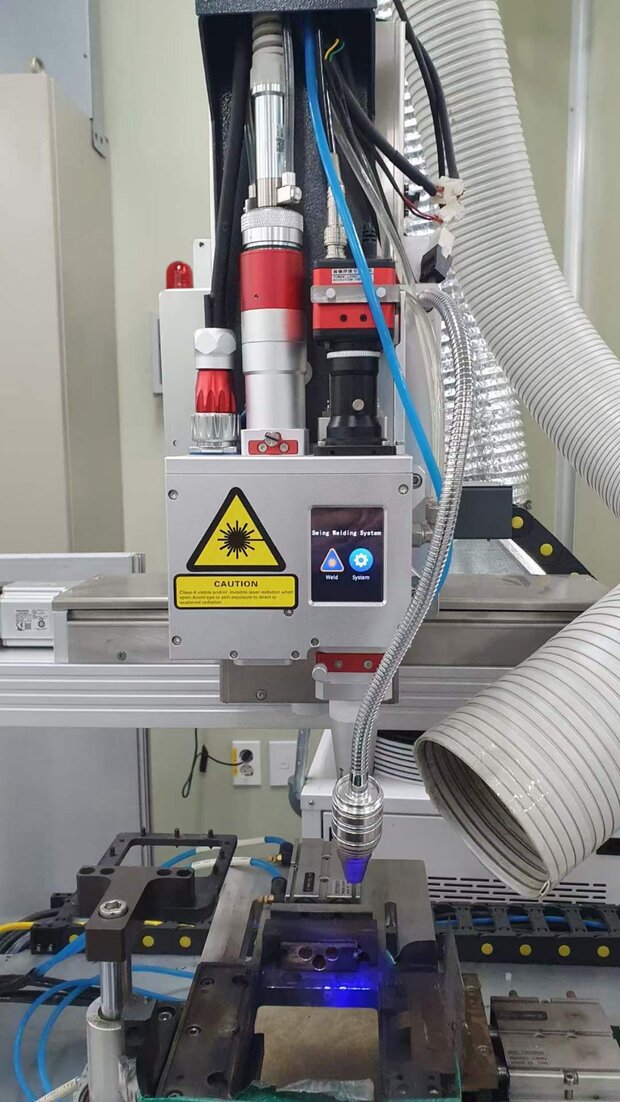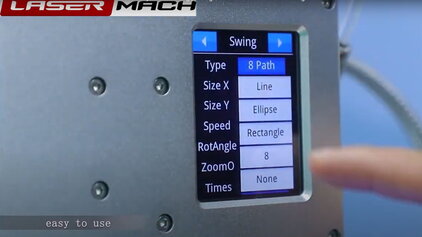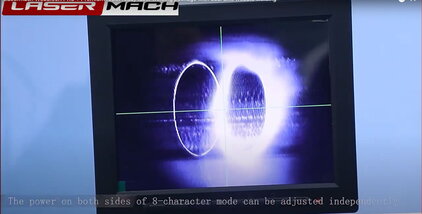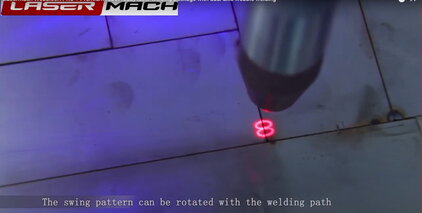PhotonWeld CUBE
3D/4D
3/4 Axis CNC Laser Welding
PhotonWeld CUBE
4D
5/6 Axis CNC Laser Welding
PhotonWeld CUBE
5D/6D
6/7/8 Axis CNC Laserwelding

A WORLD-CLASS LASER WELDING MACHINE MANUFACTURER
Our new PhotonWeld "WOBBLE-CUBE" Models of CNC Laser welding machines are for high quality and high-speed automatica laser welding. They adopt the fiber laser source with trouble-free lifespan +100,000 hours. Which has the advantages of high-quality beam quality, high reliability and maintenance-free, The machines are equipped with CCD liquid crystal monitoring and observation system. Observe product positioning and welding effect clearly according to red light indication. With the safety protection switch and emergency stop button, the whole laser meets international safety standards.
Features:
- Adopts continuous fiber laser source with high output power and laser beam quality
- Equipped with high power ecological industrial water chiller suitable for continuous working mode
- Equipped with CCD LCD monitoring and observation system which can clearly observe product positioning and welding effect according to the red light indication.
- Customized automatic fixtures for automatic processing and mass production with higher consistency are optional available
- Equipped with customized rotary clamps on demand for rotating laser welding on tubes
- X.Y.Z-Axis guide rail for welding irregular products. The Z-axis has a brake function.
- Rotary chuck as 4th axis available to mount on the table
State of the art of automatic laser welding
The market for automated welding is steadily growing across the world, and Europe has an excellent tradition both in terms of construction and integration of automation systems in production plants. The sectors that absorb the most production and use of industrial robots are: automotive, electronics, metals, and plastics. The inclusion of automated islands in the industrial context has changed the production cycle of many companies, increasing the quality of products and the speed of processing, thereby cutting costs and reducing safety risks for operators.
Welding and Automation : how are we doing?
The Metal sector has shown considerable interest in technological innovation in terms of increasing production and use of automation. This has led to a dynamic trend in all markets, with a high percentage of robot sales and automated systems. Indeed, annuel root consumption increases by 12~22% compared to the previous year.
Benefits of automation in welding field
Automated laser welding and joint characteristics
It is recognized that automated welding produces high quality and repeatable joints while reducing heat production, slags and, wastes during the process. The use of a welding robot avoids oversized joints, since the systems are programmed with parameters that allow to joint production with precise dimensional characteristics, avoiding expansion or contraction processes in the surrounding metal during heating and cooling cycles.
Automated systems guarantee high reproducibility and shorter cycle times in welding processes, reducing the consumption of resources and electricity compared to manual processes, thus meeting the growing need for energy efficiency. The speed of the machines is about five times higher than the average man, not to mention that the robot can move quickly from one joint to the next, allowing the execution of several operations in series.
Automation reduces labour costs and compensates for the shortage of skilled welders, as less practice is required. Therefore, the welder becomes a process monitoring operator.
Flexibility also extends to the variety of process types and joints that can be manufactured based on a variety of materials and components. Generally speaking, the robotic stations are equipped with a repository with various welding programs that can be used on different materials and thicknesses, for example MIG, MAG and TIG. Here it is possible to install standard robots, hollow wrist robots, robots with push-pull torch or with master-slave system.
Cobotized welding
In particular, it is worth mentioning how welding benefits considerably from the use of collaborative robots (cobots), which carry out the tasks alongside the operators in the assembly lines. Cobots estimates indicate average annual growth of more than 50% until 2026. While large companies are mainly interested in installing fast-working robots in their production lines in order to maximize productivity, the cobots are more suited to the needs of small and medium-sized companies. They are slower and more flexible since they have to learn, repeat, and save movements to be carried out from the operator. In essence, the robotic arm is able to replicate, the work that a highly qualified welder would do with greater quality and in less time, implying additional health and safety benefits.
Welding requires repetitive and precise torch movements. As such, the welder’s fatigue is not an inconsiderable problem. This physical condition can lead to musculoskeletal disorders. By placing a robotic arm next to the human, fatigue is drastically reduced as the torch is manipulated by the cobot. The welders are only required to monitor the process and guide the torch where necessary. The ergonomics of the working environment is considerably improved, since the use of robots allows to avoid welding in forced positions. This prevents stress to the operator’s body and limbs experienced during manual work and risky for their health.
Carrying out the operation with the help of a robot protects the operators’ health, preventing them from being exposed to the UV/IR light generated by arc welding, which can cause visual disorders, as well as long-term carcinogenic pathologies generated by continuous exposure to smoke and toxic gases. In particular, the use of collaborative robots allows better control of emissions, thereby reducing the environmental impact.
There are considerable benefits in terms of joint quality, since the use of a robotic arm guarantees a defect rate of less than 3%, avoiding additional work processes. It is not necessary for the operator to act manually to file or roughen the beads released from the welding material or to repeat the work, using a gas torch if any defects have to be eliminated. The cobots’ precision combined with optimized welding power avoids the use of additional welding wire which causes energy and material waste. By reducing the quantity of defects and using adequate power, the use of a cobot allows to considerably reduce the consumption of gas to maintain the flame active. CO2 emissions into the environment are lower. In this regard, it should be noted that welding accounts for 4.5% of the European Union’s gross energy consumption, and arc welding produces 9.82 grams of CO2 per second.
Benefits of Automating Laser Welding
When automated, laser welding becomes a highly productive metal fabrication method.
Laser welding has emerged as one of the top applications for automation. Laser welding is unique to other welding applications since it uses a laser instead of an electric arc for joining metals together.
The top benefits of automating laser welding include:
- Cleaner Welds - Laser welding is a precise welding method, even more so when automated with welding robots. Articulated robots operate with high repeatability, steady movements, and with incredible path accuracy. Automating with the robots or cobots reduces spatter, resulting in a smooth, clean weld. Robotic laser welding increases first-run weld quality reducing the need for touchups or rework.
- Small Heat Affected Zone - Robotic laser welding uses a much smaller heat affected zone (HAZ). Not only is the heat affected zone smaller, but less heat is needed to join metals together. The robot or cobot is able to use a small heat affected zone while using lower temperatures and maintaining control over the temperature of the laser for consistent heat. A smaller heat affected zone and better temperature control reduces the risk of workpieces becoming distorted.
- No Material Contact - Unlike other robotic welding applications, laser welding robots are able to weld parts without having to touch them. The robot or cobot can laser weld parts without making contact, allowing for easier access to hard to reach workpieces. Some laser welding robots can weld from over a foot away, making them ideal for welding parts located in confined spaces. Not making contact with the materials also helps to prevent part distortion along with a small HAZ.
- Versatile - Robotic laser welding is extremely versatile. Laser welding robots can work with a variety of metal types and metal thicknesses. The small heat affected zone and low temperatures make robotic laser welding ideal for thin metals. Laser welding six axis robots can also weld thick metals by creating a deep steam capillary. This method can even weld metals that previously were not considered weldable, such as exotic metals prone to cracking, since less heat is used.
- Rapid Thermal Cycle - Automating laser welding with robots allows for a rapid thermal cycle that happens within a few milliseconds. This not only speeds up the welding process but produces a more durable weld. A rapid thermal cycle creates a better weld structure which has better mechanical properties. The weld will be more resistant to corrosion, will be stronger, and less likely to deteriorate.
- Faster Cycle Times - The robot/cobot operates at much faster speeds than a welder. Parts will be welded in less time than with manual laser welding. The elimination of touchups or rework due to the accuracy of laser welding robots further shortens the length of time to weld each part.
- Safer - Manual laser welding can be dangerous to workers, especially since the laser is not visible. Automating with welding robots eliminates safety risks from workers. Laser welding robots can be contained in robotic workcells creating a safeguarded work environment that protects workers from exposure to the laser beam.





